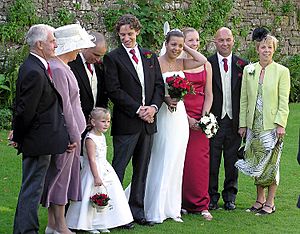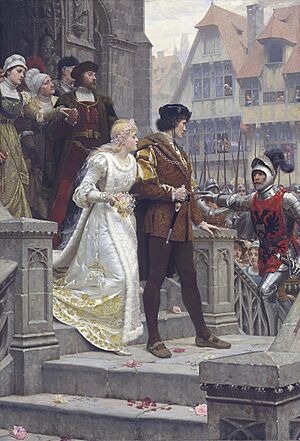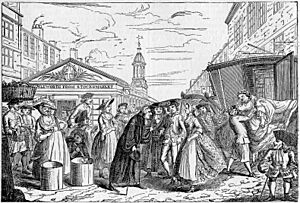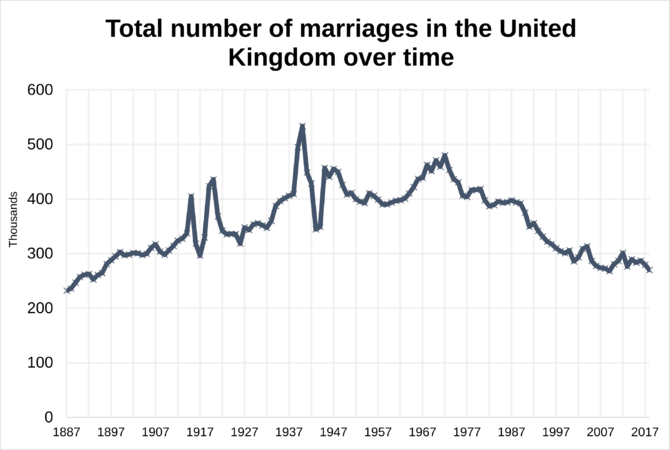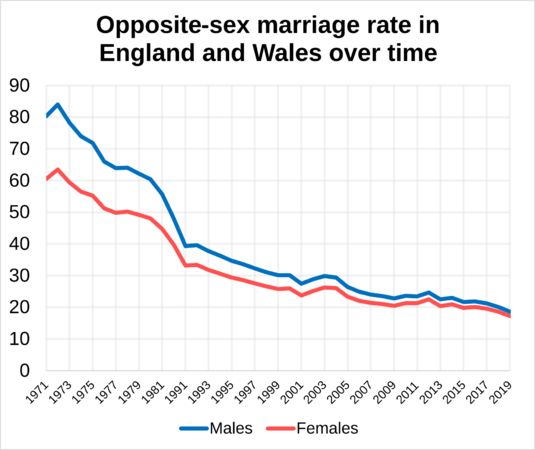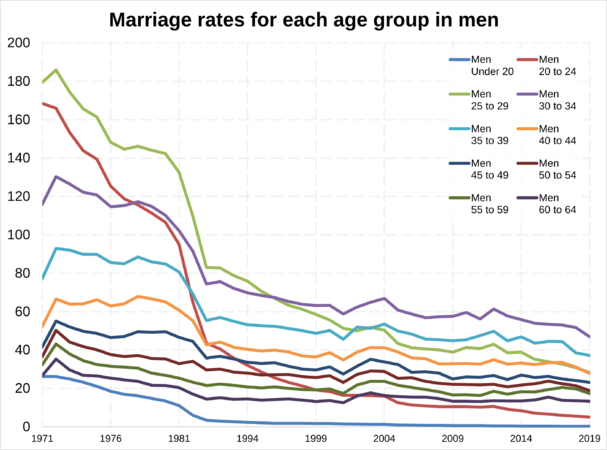Marriage in England and Wales facts for kids
In England and Wales, people can get married whether they are an opposite-sex or same-sex couple. Marriage is officially recognized as either a civil marriage (done by the state) or a religious marriage (done by a religious leader). The laws about marriage in England and Wales have grown differently from other parts of the United Kingdom. Since February 27, 2023, you must be at least 18 years old to get married in England and Wales. Before this, you could marry at 16 with your parents' permission. This age rule also applies to civil partnerships.
Some close relatives are not allowed to marry each other. If you are from another country, you also need to live in England or Wales for a certain time before you can marry here. Same-sex marriage became legal in March 2014.
The rules for weddings in England and Wales were looked at by the Law Commission. In 2022, they said the laws were confusing and old-fashioned. They suggested a full update, noting that many parts of the law were from 1836 or even earlier.
Contents
How Marriages Happen
Wedding ceremonies can be led by an "authorised celebrant" (like a religious minister) or an "authorised registrar" (a government official). For a marriage to be legal, at least two other people must be there as witnesses. The couple, the person leading the ceremony, and the two witnesses all sign the marriage register. Civil marriages cannot happen in religious buildings. However, since 1994, they can take place in other licensed places like hotels.
Priests in the Church of England and the Church in Wales must marry opposite-sex couples if one person lives in their local area. Sometimes, special permission is given for weddings outside the local area. Since 2008, people can also marry in a church where their parents or grandparents were married, or where they were baptised or confirmed. Church of England and Church in Wales priests are not allowed to perform same-sex marriages. However, the Church in Wales can ask for the law to change to allow this.
For civil marriages, a notice must be displayed for 28 days at the local register office. For Church of England weddings, the banns (a public announcement) must be read three times in the right churches. This is unless a special license is obtained. Usually, the right churches are where the couple lives and where the ceremony will happen.
A marriage is not valid if either person is under 16 years old. This is called "nonage".
Updating Wedding Laws
In 2022, the Law Commission looked at the wedding laws in England and Wales. They found that the laws did not match what couples wanted for their weddings. These laws are very old, mostly from the 1700s and 1800s. The Commission said the laws are confusing, complicated, and unfair. They noted that England and Wales were behind many other countries in updating their wedding laws.
Ending a Marriage (Divorce)
Since April 6, 2022, the law about ending a marriage (divorce) has changed. Now, people can get a "no-fault divorce." This means you no longer have to prove that one person was to blame for the marriage breaking down. Before, people had to show reasons like "unreasonable behaviour" or long periods of separation.
With the new law, you only need to state that the relationship has "irretrievably broken down." This makes the process simpler. Also, one person cannot stop or fight the divorce application, except in very rare cases. After a divorce, people are allowed to marry again in a civil ceremony. Different religions have their own rules about religious remarriage.
Benefits of Marriage
Marriage comes with some legal benefits and changes. If one spouse passes away, any gifts left to the other spouse usually do not have to pay inheritance tax. Also, if someone dies without a will, their property often goes to their spouse. Spouses may also inherit part of their partner's pension.
In court, one spouse usually cannot be forced to speak against the other. If a British citizen marries someone from another country, that person might get a residence permit to live in the UK. This depends on the British spouse earning a certain amount of money each year. Spouses are also expected to care for each other. Some social security benefits are calculated differently for married couples than for single people.
Foreign Citizens Marrying in the UK
Since February 1, 2005, visitors from outside the European Economic Area (EEA) who want to marry in the UK must get a special visa before they travel. Without this visa, they cannot give notice of marriage or have the ceremony.
If one person wanting to marry is subject to immigration control, they must both go to a special register office together to give notice. A marriage must be between two people who are not already in a civil partnership or married to someone else. Marriages from other countries are usually recognized.
History of Marriage Laws
Medieval Times
In the Middle Ages, marriage in Europe followed church law. A marriage was considered valid if the couple said they took each other as husband and wife. Witnesses or a priest were not always needed. However, in 1215, the Church said that secret marriages were not allowed. They wanted marriages to be announced publicly in churches by priests.
From about the 1100s to the 1600s, "handfasting" was common in England. This was like an engagement, or a ceremony where a couple formally agreed to marry. It usually happened about a month before a church wedding.
Handfasting was legally binding. As soon as the couple made their promises, they were considered married. It was not a temporary thing. Just like church weddings back then, a handfasting union could only end with death. English law said handfasting was as strong as a vow made in church.
During handfasting, the man and woman would hold right hands and say aloud that they accepted each other as husband and wife. They might say something like, "I (Name) take thee (Name) to my wedded husband/wife, till death us depart." This is why handfasting was also called "troth-plight." Couples often exchanged gifts, especially rings. Sometimes, a gold coin was broken in half between them. Handfasting could happen anywhere, like in a home, a tavern, or even on horseback. It was common to have witnesses.
Church courts handled marriage matters. They recognized two types of handfasting: one where the couple said they were married right then, and another where they only promised to marry in the future. The future promise could be ended if both people agreed.
In the 1500s, the Council of Trent made new rules for marriage. These included needing a priest and two witnesses, and announcing the marriage 30 days before. These rules did not apply to areas affected by the Protestant Reformation. Even though handfasting was valid, couples were expected to have a church wedding soon after. There could be penalties if they did not. Sometimes, people who had done "troth-plight" refused a church wedding, which caused confusion about their marriage status.
The famous writer William Shakespeare was a witness to a handfasting in 1604. Historians think he might have married Anne Hathaway this way in 1582, as it was still common where he lived.
1600s to 1800s
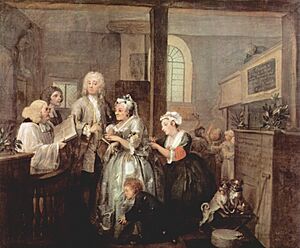
After the early 1600s, English law slowly changed. It became necessary to have a priest or a government official present for a marriage to be legal. Before this, many secret marriages, like the "Fleet Marriages," were still considered legal. In Scotland, informal common-law marriages were also valid.
Laws in 1694 and 1695 said that couples needed to get banns or a marriage license. The Marriage Act of 1753 also set rules for where marriages could happen, who you could marry, and required at least two witnesses. It also set a minimum age for marriage. Because of these strict rules, many couples who could not meet the conditions in England and Wales would run away to Scotland to get married.
The 1753 Marriage Act, also known as Lord Hardwicke's Marriage Act, mostly ended common-law marriages. This law aimed to stop secret marriages by making the rules much stricter. After this, only marriages done by the Church of England, Quakers, or under Jewish law were recognized in England and Wales. Any other type of marriage was no longer legal. Children born from unions not valid under this Act could not automatically inherit property or titles. For historical reasons, this Act did not apply in Scotland.
The Marriage Act 1836 brought back civil marriage. It also allowed ministers of other faiths, like Protestants and Roman Catholics, to act as registrars. Some people who felt that marriages outside the Anglican church were not proper called this the "Broomstick Marriage Act."
This law also stopped certain relatives from marrying each other, like a man marrying his deceased wife's sister. These rules were largely based on the "Table of kindred and affinity" in the Anglican Church's prayer book.
1900s Changes
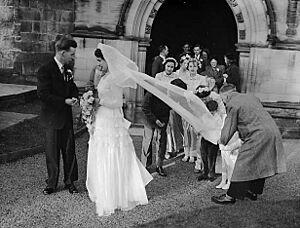
The list of relatives who could not marry each other was shortened in the early 1900s. For example, a man was allowed to marry his deceased wife's sister from 1907.
The Age of Marriage Act 1929 raised the minimum age for marriage to 16 with parental permission, and 21 without it. This law was passed because groups like the National Union of Societies for Equal Citizenship campaigned for it. Before this, people could marry at 14 for males and 12 for females. The 1929 Act made any marriage where either person was under 16 invalid.
The Marriage Act 1949 made it illegal to marry in the evenings or at night. This rule had been in place since 1836, forbidding marriages between 6 PM and 8 AM. This ban was removed on October 1, 2012.
Later, in 1987, the law changed again, lowering the age for marriage without parental consent to 18.
The Marriage Act 1994 allowed marriages to take place in "approved premises" like hotels. Before this, ceremonies could only happen in churches and register offices.
2000s and Today
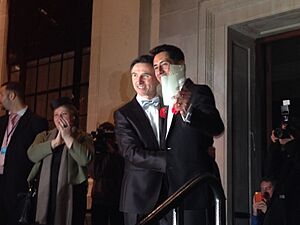
In 2013, Parliament passed a law allowing same-sex marriage in England and Wales. Same-sex weddings started on March 29, 2014. However, same-sex marriages performed in other countries were recognized from March 13, 2014. Before this, civil partnerships were available to same-sex couples in 2005. These gave almost the same rights as civil marriage.
On February 27, 2023, the minimum age for marriage was raised to 18 years old. This was done by the Marriage and Civil Partnership (Minimum Age) Act 2022. This law also makes it a crime to force someone under 18 into any religious or civil ceremony, even if it's not legally binding. This helps prevent forced marriages.
Royal Marriages
Marriages of the royal family used to be controlled by a law from 1772. This law said that any royal family member under 25 needed the monarch's permission to marry. If they were over 25 and refused permission, they could still marry one year later, unless Parliament voted against it.
A new law in 2013 changed this. Now, only the first six people in line to the throne need the monarch's permission to marry. If permission is refused, they can still marry, but they and their children will not be able to inherit the Crown.
In 2002, the Church of England changed its policy on remarriage. This happened shortly before Prince Charles was going to marry Camilla Parker Bowles, who had been divorced. In 2005, the Queen formally agreed to their wedding.
The royal family was not included in the 1836 Marriage Act, which started civil marriages. However, Prince Charles's civil marriage raised questions. It was later confirmed that it was legal for them to have a civil ceremony under the 1949 Marriage Act. Any doubts were cleared up by the Human Rights Act 1998, which says laws should be understood to allow the right to marry without unfair treatment.
Marriage Statistics
- Statistics on marriage (in England and Wales if not specified)
See also
- Civil Partnership
- Fleet Marriage
- History of marriage in Great Britain and Ireland
- Marriage Certificate
- Marriage in Northern Ireland
- Marriage in Scotland


